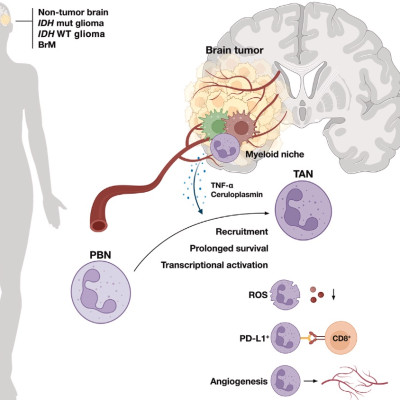Publication
The local microenvironment drives activation of neutrophils in human brain tumors
Maas RR, Soukup K, Fournier N, Massara M, Galland S, Kornete M, Wischnewski V, Lourenco J, Croci D, Álvarez-Prado ÁF, Marie DN, Lilja J, Marcone R, Calvo GF, Santalla Mendez R, Aubel P, Bejarano L, Wirapati P, Ballesteros I, Hidalgo A, Hottinger AF, Brouland JP, Daniel RT, Hegi ME, Joyce JA
Cell 186, 1-21 (2023)
MOLAB authors
Abstract
Neutrophils are abundant immune cells in the circulation and frequently infiltrate tumors in substantial numbers. However, their precise functions in different cancer types remain incompletely understood, including in the brain microenvironment. We therefore investigated neutrophils in tumor tissue of glioma and brain metastasis patients, with matched peripheral blood, and herein describe the first in-depth analysis of neutrophil phenotypes and functions in these tissues. Orthogonal profiling strategies in humans and mice revealed that brain tumor-associated neutrophils (TANs) differ significantly from blood neutrophils and have a prolonged lifespan and immune-suppressive and pro-angiogenic capacity. TANs exhibit a distinct inflammatory signature, driven by a combination of soluble inflammatory mediators including tumor necrosis factor alpha and Ceruloplasmin, which is more pronounced in TANs from brain metastasis versus glioma. Myeloid cells, including tumor-associated macrophages, emerge at the core of this network of pro-inflammatory mediators, supporting the concept of a critical myeloid niche regulating overall immune suppression in human brain tumors.















